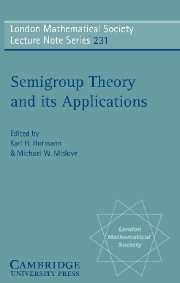 Semigroup Theory and its Applications
Semigroup Theory and its Applications Book contents
The relationship of Al Clifford's work to the current theory of semigroups
Published online by Cambridge University Press: 05 April 2013
Summary
Before I discuss the mathematical work of Al Clifford and the relationship of his body of work to the current theory of semigroups, let's first consider the more general question: how does one discuss any mathematician's 50 years of work in relation to the current status of all work? This discussion is taking place a relatively short time after the mathematicians's death.
Perhaps at the minimum the following five aspects should be discussed. First, how the past has affected the mathematician's life work and how this life-work has influenced the future to date. At the very least, influences from the past would include: education, the people who personally and directly influenced the mathematician, research papers by others which exerted great influence, the books read, etc. This aspect is represented by
Second, there is a major philosophical dialectic between ideas and language, represented by
A famous example of this is the Newton-Leibnitz idea of limit or infinitesimals and the Weierstrass language and precise definition of limit (by ∀∃∀ using δ and ε). Where the specific mathematician stands (as defined by the acts of his/her life work) on this dialectic can often lead to insight into his/her life work.
A related issue is the dialectic between scholarship coupled with knowledge vs. new research, or
These last two issues are perhaps special cases of a basic dialectic tension between truth and beauty, or
Is truth beautiful? Is beauty always truthful? In a conflicting situation, which path did the mathematician follow? (At which point do we abandon ugly proofs? Is the final result worth a very ugly proof?)
- Type
- Chapter
- Information
- Semigroup Theory and its ApplicationsProceedings of the 1994 Conference Commemorating the Work of Alfred H. Clifford, pp. 43 - 52Publisher: Cambridge University PressPrint publication year: 1996
- 1
- Cited by


